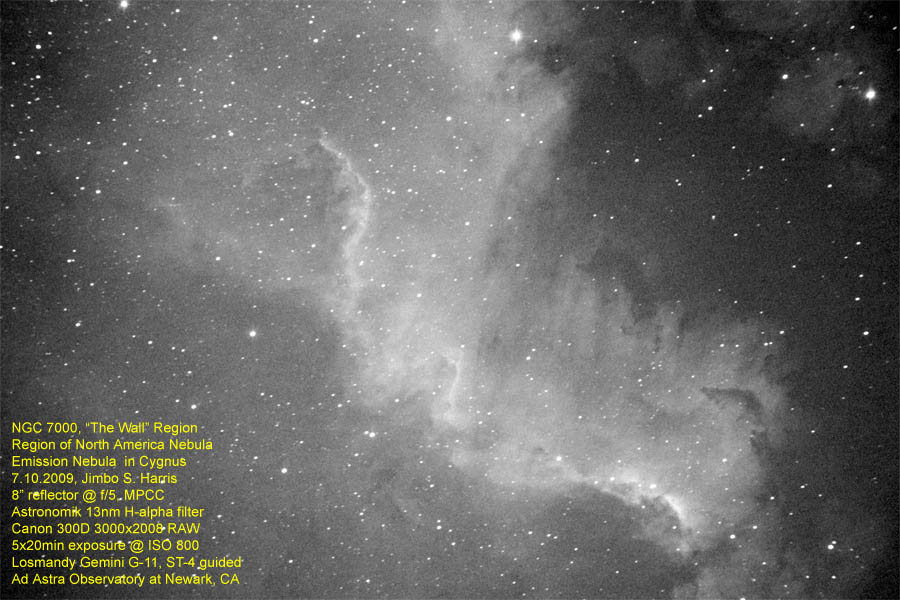Now that the Gemini mount is back in service, I decided to try out higher-magnification photography with the new Ha filter. I had a little maintenance to do first; focusing both cameras and aligning the finders. This goes quicker and quicker each time I try it. During the bright moon, I had also rebalanced the scope further forward (in hopes that I’d get more time imaging before the scope hit the mount), and tightened up the Dec axis (which had come loose during its transit to and from repairs in WA).
With everything ready, I needed to decide on a target. The skies were a little hazy, but the guide scope aligned right away, so I figured I could get some photons in before it really clouded over.
I retried my old nemesis (now turning into a bit of an old favorite), NGC 7000, The North America Nebula. I knew that Veronica would only get a small portion of the nebula compared to Pumpkin, and from my previous shot, I knew just the section I wanted to magnify; the “Central America” region of NGC 7000 is the brightest part, and has lots of wispy detail. I hoped this might fit in Veronica’s FOV. After a little “hunt-n-peck” shooting in the area, I figured out where the portion I wanted was (GOTO doesn’t help much in this case, so I had to resort to using a star chart and my knowledge of the area to find it), I found a nice bright guide star (a little brighter than normal because of the clouds), and started up a long imaging sequence.
When I woke up in the morning, the scope had hit the pier again as usual, but it had time to capture 15 frames, so I was looking forward to seeing what I’d captured. When I checked my images, I’d of course lost the last 3 to tracking errors, but unfortunately, it looks like the clouds ate several more. Only the first 5 images were usable, so this is an hour and 40 minutes. Having said that, I’m far from disappointed with the results:
Wow. Veronica does a great job on Ha, and the framing was exactly what I was hoping for. I’d love to see more integration time, but I’m pretty satisfied with what I’ve got.
When I woke up at 5am to shut everything down, there were two really pretty solar system pairings in the sky. High in the southwest were the moon (waning gibbous) and Jupiter. Fairly high in the east (between Aldebaran and The Pleiades) were Venus and Mars. Very cool!


MOST COMMENTED
Observatory
Observatory 2.0 – Time has come today!
General / Maintenance
First Light, a deeper look
Mount / Observatory / Telescope
Observatory 2.0 – Result!
Observatory
Observatory 2.0 – The Pier goes in
Gear / General / Maintenance
Martin Farmer Wormblock installation notes
Deep Sky / Long Exposure Photography
NGC2244, The Rosette Nebula
Deep Sky / Long Exposure Photography
Another beautiful night.